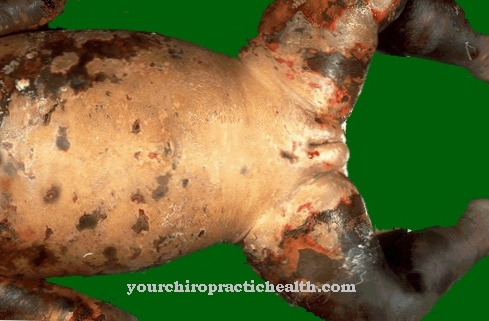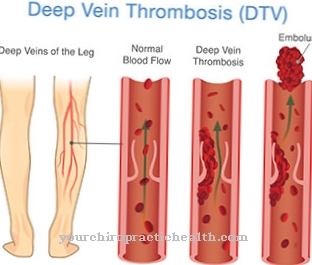Of the Hydrops fetalis refers to the accumulation of fluid in several fetal compartments, serous cavities or soft tissues. It is a serious symptom of various congenital diseases that cause anemia in the fetus. The hydrops fetalis can be diagnosed sonographically.
What is fetal hydrops?

© petrrunjela - stock.adobe.com
Of the Hydrops fetalis is a term used in prenatal diagnosis and describes a generalized accumulation of fluid in the fetus. The fluid or the edema are located in at least two fetal compartments, in serous body cavities such as the pleura, peritoneal cavity and pericardium or in the soft tissues.
The edema can spread to large parts of the unborn child's body. Hydrops fetalis occurs with a frequency of 1: 1500 to 1: 4000 pregnancies. Depending on the cause, a distinction is made between immunological and non-immunological hydrops fetalis, but an assignment is only possible in around 50 percent of cases.
Since the occurrence of fluid accumulation in the child suggests a chromosome peculiarity, an organic malformation or a serious illness of the fetus, hydrops fetalis is one of the sonographic soft markers during pregnancy. This can be used to diagnose serious diseases of the child prenatally.
causes
Fetal anemia is almost always the cause of hydrops fetalis. This results in hypoxic damage to the capillary walls, whereby their permeability is increased and fluid from the intravascular space reaches the extravascular space. These anemias can be caused immunologically or non-immunologically.
The rhesus incompatibility between mother and child is one of the immunological causes. This leads to massive hemolysis and anemia in the unborn child in the second child. Less common immunological causes are fetofetal transfusion syndrome and thalassemia.
In the meantime, predominantly non-immunological causes cause hydrops fetalis. Congenital deformities of the heart often result in fetal anemia. Increasing the cardiac output to compensate for the anemia can lead to heart failure and increased fluid retention.
Infections with toxoplasmosis, syphilis connata, rubella or cytomegalovirus are also among the non-immunological causes. Hydrops fetalis is also observed more frequently in a number of diseases such as Turner syndrome, trisomy 18 or Down syndrome.
Symptoms, ailments & signs
The unborn child has fluid retention or edema in the fetal compartments, serous cavities, or soft tissues. The most common occurrences here are ascites, pleural effusions and polyhydramnios.
Ascites, also known as ascites, is the accumulation of water in the abdominal cavity. The pleura is a two-leaved skin that envelops the lungs and lines the chest. With a pleural effusion, fluid accumulates in the narrow gap between the lungs and the chest wall.
Polyhydramnios refers to an above-average amount of amniotic fluid with an amniotic fluid index of over 20 centimeters or an amniotic fluid reservoir larger than eight centimeters. The accumulation of fluid in the soft tissues occurs relatively early.
In most cases, the fetus exhibits cardiac pumping weakness with increased cardiac output. After birth, the children suffer more from newborn jaundice; the anemia and edema are still present.
Diagnosis & course of disease
The presence of fetal hydrops is determined intrauterine by ultrasound. In the child, the lifting of the skin from the body by the edema is clearly visible. If a risk factor for the development of fetal anemia is known, the pregnancy can be monitored by regular sonographic examinations in order to be able to counteract fetal hydrops if necessary.
Taking blood from the umbilical cord can indicate anemia early on. A heart defect can be identified using echocardiography. Thanks to the modern diagnosis and therapy options, around 85 percent of children can survive hydrops fetalis of immunological origin. However, if there is a non-immunological cause, fetal mortality is over 80 percent.
Complications
Hydrops fetalis can cause various complaints. In many cases the fetus is affected by the disease. The affected person suffers from so-called ascites, whereby water collects in the abdominal cavity. This build-up can later lead to difficulty breathing and continued shortness of breath.
There is also water retention in the soft tissues of the person affected. The heart is heavily stressed by the hydrops fetalis, which can lead to damage and limitations to the heart. The liver is also damaged, so most children are born with newborn jaundice. If the complaints are not treated, the patient usually dies prematurely.
In most cases, the treatment of hydrops fetalis is causal and symptomatic. Often the symptoms can be limited by a blood transfusion. In severe cases, however, the pregnancy must be terminated if the mother's health is also endangered. After birth, the children may need to be ventilated to survive. As a rule, it cannot be predicted whether the disease will develop positively.
When should you go to the doctor?
The presence of hydrops fetalis is usually determined during the ultrasound examinations during pregnancy. At the latest after birth, the disease can be recognized based on the typical external characteristics. Whether further medical examinations are required after the diagnosis depends primarily on the severity of the disease. Light build-ups of fluid sometimes resolve on their own. In severe cases, treatment must be started during pregnancy.
Mothers who experience abdominal pain, possibly associated with unusual contractions of the baby, should speak to the gynecologist. If there are signs of a water belly, a doctor must be consulted immediately. The disease must be clarified and treated immediately to rule out serious complications for mother and child. If the therapy is successful, no further treatments are required. However, the mother should continue to watch out for any symptoms and, if not already done, inform the obstetrician in the hospital about the hydrops fetalis at the birth. In this way, the child can be examined immediately after birth and, if necessary, provided with the appropriate medication.
Doctors & therapists in your area
Treatment & Therapy
Hydrops fetalis must be treated by eliminating the cause. As a rule, this is fetal anemia, which can be corrected intrauterine via the umbilical cord with blood transfusions. In the case of fetofetal transfusion syndrome during a twin pregnancy, the anastomoses in the bloodstream of the twins, which cause an uneven blood distribution between the children, can be closed by means of laser coagulation.
If the hydrops fetalis is the result of a cause with a poor prognosis, a medical consultation is necessary in order to discuss the therapeutic options, the consequences for the child and, above all, the risks for the mother with the parents. An abortion for medical reasons may have to be considered.
If left untreated, hydrops fetalis not only has serious consequences for the child. In particularly severe cases, the mother can also develop symptoms that reflect the hydrops fetalis. This clinical picture is called maternal hydrops syndrome and symptomatically is very similar to severe preeclampsia.
Postnatally, children suffering from hydrops fetalis require intensive medical care. The children often have to be intubated and artificially ventilated, receive blood transfusions and are treated for jaundice with phototherapy or blood exchange. Ascites and pleural effusions are punctured for relief. The causal disease is then treated as far as possible.
You can find your medication here
➔ Medicines against edema and water retentionOutlook & forecast
The prognosis for hydrops fetalis is related to the cause of the water retention. If there is a congenital disease or a chromosomal peculiarity of the fetus, it will be born with this underlying disease and the visible water retention may not have receded by then. Depending on the health of the mother and child, a incision can be useful in such cases so that neither is injured during the birth.
If, in addition to the hydrops fetalis, the child is diagnosed with such severe damage that it would only be born handicapped or not viable at all, then a late termination of the pregnancy can be considered. This is a very intimate and difficult decision, but it offers a way out of a life full of suffering and pain for the unborn child in the event of disease triggers with very poor prognoses. With the common cause of fetal anemia, a blood transfusion can be administered via the umbilical cord in the womb, which significantly improves the baby's prognosis.
Other triggers of hydrops fetalis can already be treated during pregnancy so that the child is born as healthy as possible and, at best, even a natural delivery is possible if the woman wants this type of delivery and feels safe.
prevention
Whether or not hydrops fetalis can be prevented depends largely on the cause of the fetal anemia. In the case of congenital malformations, only close ultrasound monitoring of the pregnancy helps in order to be able to intervene early on. Rhesus incompatibility can be counteracted by rhesus prophylaxis during the first pregnancy.
The child's erythrocytes in the maternal blood are thereby masked and broken down without the formation of antibodies. Even if you want to have children, vaccination protection or antibodies against infectious diseases should be checked.
Aftercare
In general, it cannot be predicted whether special follow-up measures will be available to those affected by hydrops fetalis, as these are highly dependent on the underlying disease. However, it is a serious illness that should be recognized and treated by a doctor as soon as possible. Independent healing cannot occur, and in the worst case scenario, the child may die if the hydrops fetalis is not treated.
In some cases, hydrops fetalis requires termination of the pregnancy. After such an abortion, the parents will in most cases need psychological support. Above all, the help and support from your own family or friends is very important in order to prevent depression and other psychological upsets.
If the child survives the birth, it will need constant medical supervision. Even then, the parents are mostly dependent on psychological support. The parents must strongly encourage the child in further development in order to counteract damage and avoid further complications. No general prediction can be made about the further life expectancy of the child.
You can do that yourself
Hydrops fetalis disease cannot be treated by means of self-help. In this case, a visit to a doctor is always necessary. If no treatment is found, the unborn children can die of this disease. In some cases, the pregnancy must be completely terminated if the treatment would pose too high a risk for the mother.
For this reason, self-help is limited to treating possible psychological complaints. Detailed discussions with your own partner, family or, of course, friends can be very helpful in order to prevent or treat depression and other psychological upsets. However, such discussions do not replace professional therapy by a therapist. Therefore, if they are not helpful, a psychologist should be consulted.
Contact with other affected parents can also be helpful. This often leads to an exchange of information, which may improve the quality of life of the person concerned and thus make everyday life easier. It can also be worth visiting a self-help group to talk about the disease.






.jpg)


















.jpg)

.jpg)
